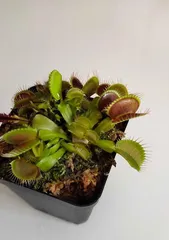The Venus flytrap is a magical plant that can absorb nutrients from the air and grow and develop through sunlight and water. However, improper soil mixing will affect the growth and maintenance of the Venus flytrap. Therefore, correct soil mixing and maintenance techniques are crucial for the growth and development of the Venus flytrap.

Soil Selection
When preparing soil for the Venus flytrap, be sure to choose loose, well-draining, and breathable acidic soil. Common acidic soils include peat moss, perlite, and sulfate.
Use of Peat Moss
Peat moss is one of the most commonly used substrates for cultivating Venus flytraps. It is rich in organic matter and low-melting-point minerals, which can provide sufficient nutrients and maintain proper humidity for the Venus flytrap.

Use of Perlite
Perlite is a light, inorganic substrate. Its special structure can regulate soil pH and maintain moisture, making it suitable for mixing with peat moss.
Use of Sulfate
Sulfate is an extremely acidic substrate suitable for the growth of Venus flytraps. However, sulfate is highly corrosive and requires protective equipment such as gloves and masks for handling.
Adding Sand
When preparing the substrate for the Venus flytrap, you can add fine sand to increase soil aeration and drainage. However, be careful that too much sand will affect the acidity and nutrient content of the soil.

Proportion Ratio
The ratio for preparing the Venus flytrap substrate varies in different situations. Generally, the ratio of peat moss to perlite is 1:1, and the proportion of sulfate can be appropriately reduced.
Water Quality Requirements
Venus flytraps need pure water for irrigation, preferably deionized water or rainwater. If using tap water, let it sit for 1-2 days first to allow the chlorine to evaporate.
Watering Requirements
When maintaining a Venus flytrap, it is important to control the amount and time of watering. Venus flytraps prefer to be slightly dry rather than waterlogged. Generally, water once a week to keep the soil moist.
Sunlight Requirements
Venus flytraps love a sunny environment and need at least 4 hours of sunlight per day. However, avoid high temperatures and direct sunlight, as this will affect their growth and development.
Temperature Requirements
The growth temperature of Venus flytraps is generally between 10°C and 32°C, with the most suitable temperature being 18°C to 25°C. If the temperature is too high or too low, it will adversely affect the growth and development of the Venus flytrap.
Fertilizer Use
The Venus flytrap is a special plant that does not require conventional fertilizers. Adding too much fertilizer will instead affect its growth and health.
Trimming Dead Parts
During the growth and development of the Venus flytrap, dead leaves and flower stalks should be trimmed in time to avoid affecting its health and appearance.
Pest and Disease Prevention
Venus flytraps are susceptible to pests and diseases. Pay attention to regular pest and weed control, and use appropriate chemicals for pest and disease prevention.
Transplanting
Venus flytraps grow quickly and can be transplanted when the plant becomes too large. Before transplanting, the old soil should be completely removed, and care should be taken to avoid damaging the plant.
The Venus flytrap is a unique plant, and correct soil mixing and maintenance techniques are essential for its healthy growth. Selecting the right soil, mastering watering and light requirements, and paying attention to pest and disease prevention are all key to successfully caring for a Venus flytrap.